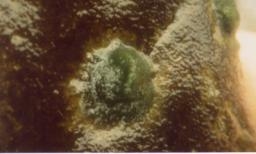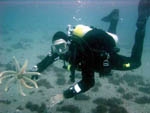PDF of this article (123 KB)

Lampreys run at Monowai

In springtime, adult lampreys (Geotria australis) enter fresh water to spawn after 2–3 years at sea where they feed parasitically on marine fish and mammals. The adults are secretive and seldom seen, and it was discovered only a few years ago that they spend up to 18 months in fresh water before spawning, during which time they don’t feed. Adults are occasionally seen when they congregate below dams, weirs, and waterfalls.
One such gathering was witnessed in 1997, when lampreys ascended a juvenile eel pass installed below Roxburgh Dam (Water & Atmosphere 5(4): 5). In September this year, NIWA staff working on didymo control trials at the Monowai research facility were surprised to find a mass of about 500 adult lampreys attempting to climb the concrete apron, apparently attracted by the discharge from the trial troughs. Previous tracking of lampreys equipped with radio tags in the Mataura River had indicated that they were attracted to certain waterways and not others.
Recent studies on sea lampreys (Petromyzon marinus) in North America have shown that migratory adults are selecting spawning streams based on a pheromone released by larvae living upstream. The pheromone consists of three bile alcohols produced by the liver. Researchers at NIWA are determining if native New Zealand lamprey could also be selecting spawning streams based on this pheromone mixture.
For further information, contact: Dr Don Jellyman, 0-3-343 7846, [email protected] Dr Cindy Baker, 0-7-856 1774, [email protected]
Marsden Fast-Start award for marine ecology study

Earth is in the midst of a biodiversity crisis, with species declining at high rates and on massive scales. The loss of species will eventually change the way ecosystems function, with flow-on effects for the goods and services that we humans derive from the environment. Drew Lohrer, a marine ecologist at NIWA in Hamilton, has received a Marsden Fast-Start award for research designed to determine how species loss will alter ecosystem functioning in coastal seafloor habitats. In particular, the research will test how relationships between species diversity and ecosystem functioning change across spatial and temporal scales.
The sand and mud habitats that dominate the seafloor are highly amenable to tests of ecosystem functioning because a range of functions (such as primary production and the provision of nutrients) can be measured accurately in the field together with levels of animal activity, abundance, and diversity. A multi-scaled analysis will allow Lohrer’s team to determine the consistency of patterns among sites, to see whether short-term responses translate into longer-term results, and to examine how local processes match up with the ecosystem-wide trends. This nested combination of methods will better define ecosystem functioning at the ecosystem scale, representing a significant advance over predictions based on individual experiments.
For further information, contact: Dr Drew Lohrer, 0-7-859 1803, [email protected]
Wastewater award
At the New Zealand Water and Wastes Association Annual Conference in October, NIWA scientist Graham McBride and co-authors John Moore (Christchurch City Council) and Cliff Tipler (URS) received the Ronald Hicks Memorial Award. This award acknowledges an article or paper significant in solving or clarifying sewage treatment or water pollution problems in New Zealand. Graham and his co-authors received the award for their paper on ‘Comparing human health risk outcomes for the proposed Christchurch City Ocean Outfall: a quantitative approach’, presented at the 2005 NZWWA conference. The judging panel particularly endorsed the paper’s conclusion that Quantitative Microbial Risk Analysis has much to offer in comparing the consequences of various options for wastewater treatment and discharge locations.
For further information, contact: Graham McBride, 0-7-856 1726, [email protected]
